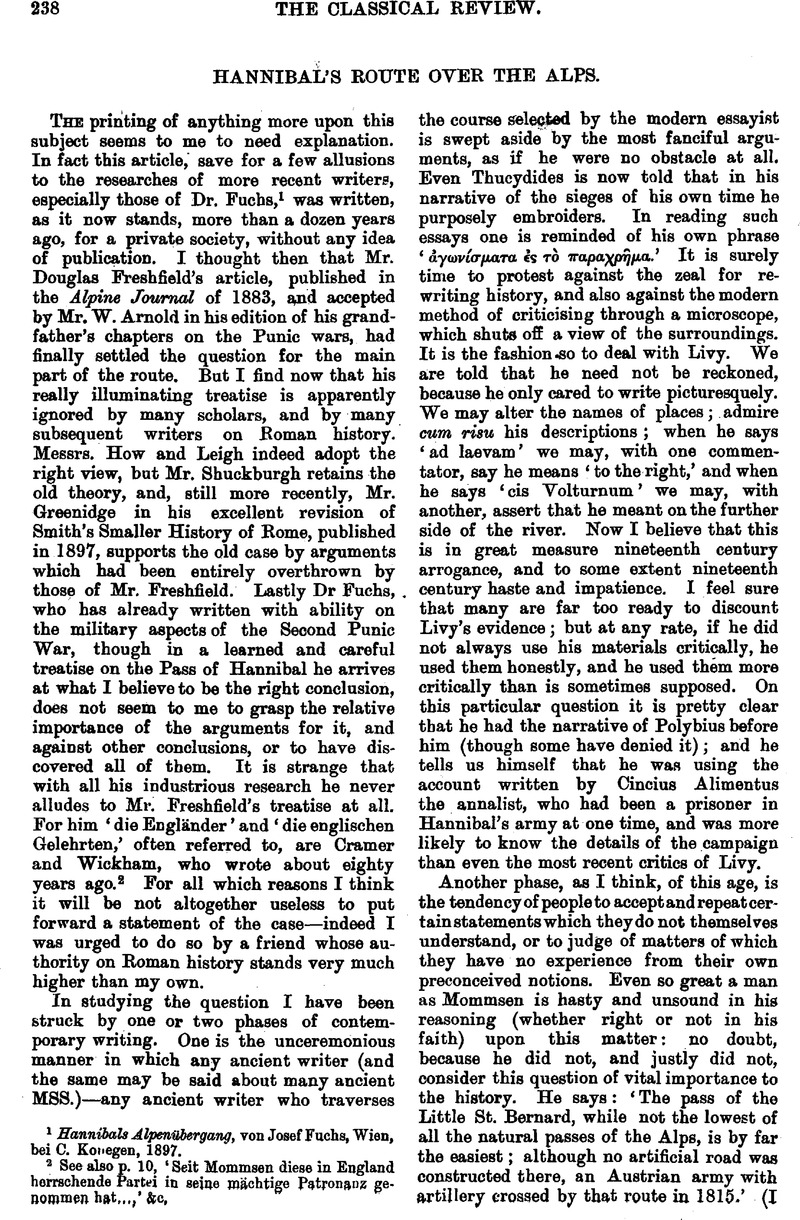No CrossRef data available.
Article contents
Hannibal's Route over the Alps
Published online by Cambridge University Press: 27 October 2009
Abstract

- Type
- Original Contributions
- Information
- Copyright
- Copyright © The Classical Association 1899
References
page 238 note 1 Hannibals Alpenübergang, von Josef, Fuchs, Wien, bei C. Konegen, 1897.Google Scholar
page 238 note 2 See also p. 10, ‘Seit Mommsen diese in England herrschende Partei in seine mäachtige Patronanz genommen hat…,’ &c
page 239 note 1 I see that Dr. Fuchs, p. 97, mentions this report and justly sets it aside.
page 240 note 1 This is correctly perceived by Dr. Fuchs, p. 103.
page 241 note 1 See Hennebert, Hist. d'Annib. ii. p. 46.
page 241 note 2 Hennebert tries to account for his not striking up the Durance from its confluence with the Rhone by the fact that the Salyes, on the lower Durance, were hostile. His business in ‘ the island ’ is a simpler explanation.
page 242 note 1 Dr. Fuchs justly comments on this silence about the Lac de Bourget.
page 243 note 1 In a note communicated by Mr. Westlake to the Geographical Journal for last March (1899) there is a mistaken theory about the contrast between παρ' αὐτὸν τὸν π∘ταμόν and παρὰ τὸαμόν. If these expressions occurred in the same sentence, the first would mean close to the river, the second merely somewhere in the river valley. Occurring in different chapters they are, in all probability, used without any distinction at all. At any rate both mean ‘ along the river valley,’ and neither could be used by a Greek writer of an army marching across ridges ‘ parallel to, or in the general direction of, the river.’ I may take this opportunity of remarking that I think that Varro's statement is misunderstood by Mr. Westlake, and that he is consequently incorrect in saying ‘ Varro's statement that Hannibal passed by the Argentière is so clear as hardly to admit of misinterpretation.’ I hope to show further on that we ought not so to interpret it.
page 243 note 1 It is true that Dr. Hoefer (1859) did suppose Hannibal to have passed the Rhone glacier and gone over the Furka and St. Gothard passes (see Hennebert, ii. p. 46) : but it is waste of time to discuss such a theory.
page 245 note 1 I feel sure that Mr. Freshfield is right in taking this ascent to be the ἀναβολή of Polybius iii. 50. He tells us that, after marching 10 days ‘ ![]() ’ he ‘
’ he ‘ ![]() ,’ evidently his first really steep ascent. Dr. Fuchs takes this to be at Embrun in the valley of the Durance: but is it likely that crossing a watershed 4,000 feet above the sea would be unnoticed, and the slighter ascent in the river valley be made the first ἀναβολή?
,’ evidently his first really steep ascent. Dr. Fuchs takes this to be at Embrun in the valley of the Durance: but is it likely that crossing a watershed 4,000 feet above the sea would be unnoticed, and the slighter ascent in the river valley be made the first ἀναβολή?
page 246 note 1 Dr. Fuchs (p. 128) does not appear to observe that the text which he cites is merely a suggested emendation. I cannot follow him either in his argument that the passage so emended ‘ in pedum mille altitudinem ’ has the same meaning as the words of Polybius ‘ ![]() .’ The Greek can only mean horizontal distance (or distance measured along the path), and in altitudinem can refer to nothing but vertical depth.
.’ The Greek can only mean horizontal distance (or distance measured along the path), and in altitudinem can refer to nothing but vertical depth.
page 247 note 1 The sentence would no doubt run more smoothly if we had ‘et’ after impeditus, or placed ‘erat’ there; but even without change it may stand as the MSS. have it.
This is rightly taken by Dr. Fuchs, p. 09.
page 247 note 3 Plin. xxiii. §§ 54, 57 ‘Aceto summa vis est in refrigerando, non tamen minor is discutiendo…saxa rumpit infusum, quae non ruperit ignis antecedens.’ Cf. Plin. xxxiii, ch. 21. Hennebert, ii. 260, cites Dio Cassius, and Apollodorus, the architect, to the same effect.
page 247 note 4 ‘ ![]() ’ (iii. 55).
’ (iii. 55).




